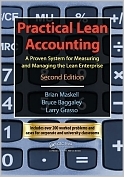Practical Lean
Accounting:
A
Proven System for Measuring and Managing the Lean Enterprise
Now suitable for classroom use, the second edition of this preeminent
practitioner’s guide to lean accounting helps readers gain hands-on experience working
with many techniques and concepts that are useful for solving business measurement
problems in lean organizations.
For each major example, three similar problems are illustrated: one for
instructors to guide students through, one for students to work through on their own, and
one for testing purposes. In addition, end-of-chapter questions reinforce learning of
basic concepts and deepen thinking about lean accounting principles and the role of lean
accounting in the lean business management system.
Table of Contents
Why Is Lean
Accounting Important?
How Standard Costing Can Drive Wrong Behavior We Need to Show the Financial Impact of
Lean Improvements We Need a Better Way to Understand Product Costs We Need New Kinds of
Lean Performance Measurements We Need to Eliminate Waste from Accounting Processes and
Systems We Need Better Ways of Making Decisions We Need to Focus Our Business around
Customer Value Summary Exercises and Discussion Questions
Maturity
Path to Lean Accounting
The Maturity Path Getting Started with Lean Accounting Summary Exercises and
Discussion Questions
Cell Performance Measurements
What’s Wrong with Traditional Measurements?
What’s Right with Lean Cell Measurements?
BMA, Inc. Performance Measurement Starter Set Day-by-the-Hour Report First-Time-Through
Report WIP-to-SWIP Report Operational Equipment Effectiveness Other Support Measurements
in the Cell Presenting the Information Making the Cell Performance Measurements Work
Nonproduction Cells and Departments Summary Exercises and Discussion Questions
Financial
Benefits of Lean Manufacturing
The Problem Creating the Box Score Managing Capacity Making Money from Lean
Manufacturing Eliminating Wasteful Transactions What Must Be in Place?
Cell Transactions Labor Tracking Material Costs Inventory Tracking Summary
Lean Financial Accounting
A New Perspective on Internal Accounting Control Eliminating Waste from the Financial
Accounting Processes Using Lean Tools to Create Change
Managing by Value Stream
What Is a Value Stream?
Different Kinds of Value Streams Why Do We Focus on Value Streams?
Why Should We Manage the Business through the Value Streams?
Continuous Improvement The Maturity Path to Lean Value Stream Organization Problems and
Issues How Do We Identify the Value Streams?
Do We Need to Change Our Organization Chart?
Develop a Plan Summary
Value Stream Performance Measurements
What Is the Purpose of Value Stream Performance Measurements?
Value Stream Continuous Improvement Teams Value Stream Measurements and Process Control
How Do Value Stream Measurements Differ from Traditional Metrics?
Box Scores Sales per Person Alternative Measurements On-Time Shipment Dock-to-Dock Time
First Time Through Average Cost per Unit Accounts Receivable Days Outstanding Supporting
Measurements Presenting the Information Making the Value Stream Performance Measurements
Work Summary
Value Stream Costing
What Is Wrong with Traditional Standard Costing?
How Does Value Stream Costing Work?
Why Is Value Stream Costing Simple?
How Can We Implement Value Stream Costing?
How Do We Handle Costs Outside the Value Stream?
How Do We Know the Cost of a Product?
Value Stream and Plant Profit and Loss Statements Calculating the Cost of Inventory
Special Problems Involving Inventory Getting Started with Simpler Methods Summary
Using the Box Score
Reporting Value Stream Performance Showing the Effects of Lean Improvements Showing
the Effects of Strategies and Plans Summary
Calculating
Product Costs—Features and Characteristics
What Drives Cost in a Lean Value Stream?
How to Use Features and Characteristics Uses of Features and Characteristics Costing
Summary
Eliminating More Wasteful Transactions
Labor Tracking Material Costs Inventory Tracking The Internal Control System Sales,
Operational, and Financial Planning (SOFP)
Purpose of Lean Sales, Operations, and Financial Planning Lean Financial Planning Lean
Sales, Operations, and Financial Planning Value Stream Demand Planning Value Stream
Operations Planning SOFP Planning Meeting Executive SOFP Meeting Variations on a Theme
Making It Happen Summary
Lean Financial Accounting II
Further Advances in Lean Accounting Summary
The Lean Enterprise
What Is a Lean Enterprise?
What Lean Methods Support the Wider Lean Enterprise?
Why Are Lean Enterprises So Hard on Themselves?
Summary
Target Costing
How Does Target Costing Work?
Where Is Target Costing Used?
What Are the Steps We Take?
After Step 3
Target Costing at ECI, Inc.: Steps 1 through 3
Understanding Customer Value Example of Target Costing at ECI: Steps 4 through 6
Calculating the Target Costs Example of Target Costing at ECI: Steps 7 through 9
Driving to Customer Value Example of Target Costing at ECI: Steps 10 through 12
Summary
Expanding
Value Streams Outside Our Four Walls
The Lean Value Stream Revisited A Vision of the Expanded Value Stream Examining Value
and Cost within Our Own Company Example of Effective Value Stream Expansion Summary
The Lean Accounting Diagnostic
The Maturity Path Revisited Overview of the Diagnostic Tool Working with the
Diagnostic Tool Summary
Performance Measurement Linkage Chart
The Performance Measurement Framework Creating the Performance Measurement Starter Set
Steps for Developing Performance Measures in Your Company Summary
Transaction Elimination Maturity Path Table
How to Use the Maturity Path Table Transaction Elimination Process Maps Summary
Value Stream Cost Analysis
What Is Value Stream Cost Analysis Performing the VSCA Calculations Step 1: Define the
Value Stream Step 2: Analyze Capacity Future State Step 3: Simulate Uses of Capacity
Summary
Value Stream Mapping
Value Stream Maps and Lean Accounting More Value Stream Steps on the Value Stream Map
Data Box Information Summary
475 pages, Paperback
Księgarnia nie działa. Nie odpowiadamy na pytania i nie realizujemy zamówien. Do odwolania !.


